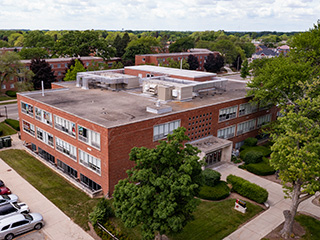Researcher hopes to harness glowing shrimp spit
Neuroscientist aims to create tools to help find cures
Can glow-in-the-dark shrimp spit help cure diseases like cancer? A Central Michigan University neuroscientist hopes his lab can provide an answer.
The cure wouldn’t come from the spit, said Eric Peterson, a research faculty with the College of Medicine. It would play a critical role in a microscopic signaling machine, however, that could help other researchers find cures.
“We are able to use the genes from these shrimp responsible for creating the component that produces light in the form of bioluminescence,” Peterson said. “We work to modify these components to be a useful tool for studying how cells and organs function.”
The shrimp, which lives in the deep waters of the ocean, uses the spit to protect itself. When predators try to eat them, the shrimp burp out a blinding, glowing goo. It creates an escape route the same way that ink helps octopi evade their predators.
Glowing shrimp spit a piece of a signaling machine
Peterson hopes to harness the bioluminescent powers of the goo to create tiny little signals inside cells that play a crucial part of the process.
The tools have two stages, he said. The first involves a protein that detects when cells are communicating in a way that suggests that a triggering activity is taking place. Using cancer as an example, that would be rapidly multiplying cells suggesting tumor growth.
The protein trips a switch in the first part of the machine, bringing together two pieces of bioluminescent shrimp spit. The effect is like closing an electrical circuit, and the spit begins to glow.
That signals to bacteria, also within the cell, to take a specific action programmed into them, he said. That could be to send a signal that tells researchers that a tumor is growing. It could also flip a kill switch that shuts down the tumor’s growth.
Diabetes, inflammation and neurodevelopment disorders are other potential applications for Peterson’s signaling biomachine.
Research has multiple campus ties
In fact, it could find use in the labs of other CMU researchers.
That’s not the only CMU connection. The university recently acquired a DNA/RNA cloning machine, one of only a few in Michigan. The cloning machine will help Peterson’s lab create the necessary volume of genetic material for his research.
Peterson’s research is being funded by a $1.8 million National Institutes of Health grant that provides flexibility if the shrimp goo doesn’t work out.
The grant, called an outstanding investigator grant, is designed to permit researchers latitude if their work takes them in a different direction than originally conceived.




